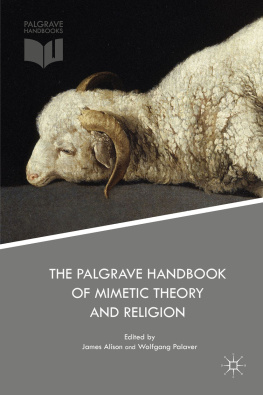Studies in Violence, Mimesis, and Culture
SERIES EDITOR
William A. Johnsen
The Studies in Violence, Mimesis, and Culture Series examines issues related to the nexus of violence and religion in the genesis and maintenance of culture. It furthers the agenda of the Colloquium on Violence and Religion, an international association that draws inspiration from Ren Girards mimetic hypothesis on the relationship between violence and religion, elaborated in a stunning series of books he has written over the last forty years. Readers interested in this area of research can also look to the associations journal, Contagion: Journal of Violence, Mimesis, and Culture.
EDITORIAL BOARD MEMBERS
Rebecca Adams, Independent Scholar
Mark Anspach, cole Polytechnique, Paris
Ann Astell, University of Notre Dame
Cesreo Bandera, University of North Carolina
Maria Stella Barberi, Universit di Messina
Benot Chantre, Lassociation Recherches Mimtiques
Diana Culbertson, Kent State University
Paul Dumouchel, Ritsumeikan University
Jean-Pierre Dupuy, Stanford University, cole Polytechnique
Giuseppe Fornari, Universit degli studi di Bergamo
Eric Gans, University of California, Los Angeles
Sandor Goodhart, Purdue University
Robert Hamerton-Kelly, Stanford University
Hans Jensen, Aarhus University, Denmark
Mark Juergensmeyer, University of California, Santa Barbara
Cheryl Kirk-Duggan, Shaw Divinity School
Michael Kirwan, SJ, Heythrop College, University of London
Paisley Livingston, Lingnan University, Hong Kong
Charles Mabee, Ecumenical Theological Seminary, Detroit
Jzef Niewiadomski, Universitt Innsbruck
Wolfgang Palaver, Universitt Innsbruck
Martha Reineke, University of Northern Iowa
Tobin Siebers, University of Michigan
Thee Smith, Emory University
Mark Wallace, Swarthmore College
Eugene Webb, University of Washington
Ren Girards Mimetic Theory
Wolfgang Palaver
Translated by Gabriel Borrud
Michigan State University Press
East Lansing
Copyright 2013 by Michigan State University
Ren Girards mimetische Theorie Lit Verlag, 2011
 The paper used in this publication meets the minimum requirements of ansi/niso Z39.48-1992 (r 1997) (Permanence of Paper).
The paper used in this publication meets the minimum requirements of ansi/niso Z39.48-1992 (r 1997) (Permanence of Paper).

Michigan State University Press
East Lansing, Michigan 48823-5245
Printed and bound in the United States of America.
19 18 17 16 15 14 13 1 2 3 4 5 6 7 8 9 10
LIBRARY OF CONGRESS CATALOGING-IN-PUBLICATION DATA
Palaver, Wolfgang, 1958
[Reni Girards mimetische Theorie. English]
Reni Girards mimetic theory / Wolfgang Palaver ; translated by Gabriel Borrud.
p. cm.(Studies in violence, mimesis, and culture series)
Includes bibliographical references (p. ) and index.
ISBN 978-1-60917-365-4 (ebook)ISBN 978-1-61186-077-1 (pbk. : alk. paper)
1. Girard, Reni, 1923 2. Imitation. 3. Mimesis in literature. 4. Philosophy, Modern. I. Title.
B2430.G494P3513 2013 2003
203'.4dc23
2012028780
Book design by Charlie Sharp, Sharp Des!gns, Lansing, Michigan
Cover design by David Drummond, Salamander Design, www.salamanderhill.com
Cover photograph of Ren Girard by Herlinde Koelbl is used with permission.
All rights reserved.

Michigan State University Press is a member of the Green Press Initiative and is committed to developing and encouraging ecologically responsible publishing practices. For more information about the Green Press Initiative and the use of recycled paper in book publishing, please visit www.greenpressinitiative.org .
Visit Michigan State University Press at www.msupress.org
Contents

Preface

The fox knows many things, but the hedgehog knows one big thing.
Archilochus
According to Roberto Calasso, Ren Girard is one of the last surviving hedgehogs.
The mimetic cycle is composed of three different components. In the first place, one finds the crisis brought about by mimetic rivalry, which we will examine at length in the third chapter of this book. Our analysis will focus on Girards articulation of mimetic desirethe anthropological core of his entire theory. The second component concerns the collective violence of the scapegoat mechanism, which transforms the chaos of the mimetic crisis into a new social order. This is the crux of Girards theory of the origin of culture, which we will address in the fourth chapter. The third component is based on the religious veiling of the scapegoat mechanism, which begins with the divinization of the sacrificed victim and forms the origin of archaic religion. In its analysis of this final component, the mimetic theory shows itself as a theory of religion that explicates the origins of archaic myth and discovers in Christianity a form of religion that differs fundamentally from paganism. While mythical religions are based on texts that are told from the perspective of persecutors, the biblical writings show solidarity with the victims of sacrificial persecution. The fifth chapter of this book presents Girards interpretation of biblical scripture.
In these central chapters, the three main elements of the mimetic theory will be discussed at length. Examples from literature will help to illustrate my presentation of Girards thought, and a comparative analysis with other philosophers and cultural thinkers will attempt to provide an intellectual positioning of the mimetic theory. These chapters build the center of a project that can be viewed as a kind of triptych: Two chapters on either side serve to complement this main middle section and can be viewed as the side panels that both refer to the center and must be understood through the concepts discussed therein. The first chapter of the left panel introduces the life and work of Ren Girard and stresses above all that his exclusive focus on the mimetic cycle is due to a personal conversion that he experienced while working on his first major study of mimetic desire: It all began for me in 1959. I felt that there was a single whole there that I had penetrated little by little. It was there in its entirety from the beginning, all parts together in one ( Quand ces choses commenceront , 189). The second chapter of the left panel examines Girards mimetic theory in the context of the contemporary debate on secularization. In a world in which the topic of religions has once again become a virulent part of political debate, all theses that had proclaimed the death of God in the modern world have proved inadequate. The mimetic theory, meanwhile, has taken a completely different path with regard to the topic of religion; since it never adopted any naive theory of secularization, it is able to explicate the complex relation of religion and modernity in a convincing fashion.
The two chapters of the right panel reflect on additional applications of the mimetic theory. The sixth chapter examines volatile political topics that include the origin of political power and the death penalty, as well as that of friend/enemy relations and war. Just as with the topic of religion, these phenomena are of increasing relevance in our world today; the mimetic theory can offer insight into the deeper connections of contemporary manifestations of crisis such as civil wars, terror, and wars against terror. The concluding seventh chapter discusses the relation between the genders [tr. Mann und Frau ] in order, on the one hand, to reject any theses that propose a fundamental difference between male and female desire and, on the other hand, to explicate the cultural tendency to stamp women as the preferred victims of collective persecution. At the end of the book, one finds an index of names and the central concepts of the mimetic theory, as well as a chronology of the significant events in Girards life and work.
Next page










 The paper used in this publication meets the minimum requirements of ansi/niso Z39.48-1992 (r 1997) (Permanence of Paper).
The paper used in this publication meets the minimum requirements of ansi/niso Z39.48-1992 (r 1997) (Permanence of Paper).

